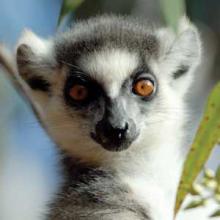Lemur catta is the most intensively studied of all lemurs (Jolly and Pride, 1999; Sauther et al., 1999; Jolly, 2003; Jolly et al., 2006a). It inhabits many forest types throughout its range, including dry scrub and Didiereaceae forest, as well as deciduous and gallery forests. Population densities vary with habitat type, with highs of 100 individuals/km2 in the dry forests of the Beza-Mahafaly Special Reserve and 250–600 individuals/km2 in the gallery forests and secondary forests of the Berenty Private Reserve (Sussman, 1991; Sauther et al., 1999; Koyama et al., 2001; Jolly et al., 2002). Ring-tailed lemurs live in multi-male multi-female groups usually numbering 6–24 animals but groups of over 30 individuals are reported occasionally (Jolly, 2003). Home range size varies from 6 to 23 ha, and groups have been recorded maintaining the same home ranges for more than three decades (Budnitz and Dainis, 1975; Sussman, 1977; Jolly and Pride, 1999; Mertl-Milhollen, 2000). Females are dominant over males and remain in their natal groups (Jolly, 1966; Sussman, 1977; Kappeler, 1990a). Males become sexually mature at about three years, and some emigrate at this time (Jones, 1983; Sussman, 1992; Koyama et al., 2002; Gould et al., 2003). Females typically have multiple mates (Pereira and Weiss, 1991). Males compete for females in “jump fights,” when they leap into the air, each opponent trying to slash the other with its upper canines and often inflicting significant wounds. Competition among females of different groups is high, the most aggressive animals typically facing off against each other and engaging in threatening behaviors, but rarely inflicting any physical damage. Within the group, however, female competition for dominance can result in serious wounds and the expulsion of inferior members (Vick and Pereira, 1989; Jolly et al., 2000), as well as the possibility of eviction and range takeover (Ichino and Koyama, 2006). Scent-marking is an important means of communication. Females demarcate the territory by marking branches with the vulva (Mertl-Milhollen, 2006; Palagi and Norscia, 2009). Males use wrist and shoulder glands to mark their tails, which they then wave at each other during ritual “stink fights.” Males also use the spurs on their forearms to make small scars in tree trunks, which they then anoint with secretions from their scent glands (Kappeler, 1998). Mating begins in mid-April and most young are born in September (Koyama, 1988; Koyama et al., 2001). Males guard their mates after copulating. Some females may be in estrus several times, as late as the middle of August (T. Soma, pers. obs.). Females first give birth at three years of age, and most produce offspring annually; single births are the norm, but twins are born on occasion. The gestation period is 138–141 days in the Berenty population (S. Ichino and T. Soma, unpubl.). The young are precocious, transferring to their mother’s back at one to two weeks old, and soon thereafter to the backs of other group members. Infant mortality is high. At Beza-Mahafaly, about half of all infants die in their first year and only about 40% reach maturity (Sussman, 1991). In the wild, the longest lifespan was recorded in Berenty, where a female reached 20 years of age (S. Ichino, unpubl.). This is the most terrestrial of the lemurs (Sussman, 1974). In Andringitra National Park, where the species occurs above the line of seasonal frost, troops regularly move along rocky, barren terrain and take shelter at night in caves (Goodman and Langrand, 1996b). The diet consists of fruit, leaves, flowers, herbs, bark, and sap from close to three dozen different plant species (Simmen et al., 2006a, 2006b). The kily tree (Tamarindus indica) is especially favored, with its fruit and leaves accounting for as much as 50% of all time spent feeding throughout the year in areas where it is present (Rasamimanana and Rafidinarivo, 1993; Sauther, 1993; Soma, 2006). Ring-tailed lemurs eat rotten wood, earth, insects, and small vertebrates, and they are also known to raid crops (Jolly, 1966; Budnitz and Dainis, 1975; Oda, 1996; Simmen et al., 2003, 2006b). In recent years, biologists and visitors to the Berenty Private Reserve have commented on the “ragged” condition of its ring-tailed lemurs. One explanation was that crowded conditions in the available habitat are having adverse effects on this population. Current studies, however, suggest that hair loss experienced by Lemur catta at Berenty is due to feeding on the leaves, fruit, and flowers of the introduced tree Leucaena leucocephala, which contains mimosine, an amino acid and known inhibitor of cell division in mammalian species (Crawford et al., 2006; Jolly, 2009a, 2009b; B. Simmen, pers. comm.). As of early 2010, Leucaena had been removed almost entirely from Berenty, and the affected groups appear to be recovering. At Berenty, some ring-tailed lemur troops also eat and very much depend upon other introduced plants such as Opuntia sp. or Azadirachla indica (Simmen et al., 2003; Pride, 2006; Soma, 2006), but the influence of these exotic foods on the health of the lemurs is not yet clear. Ring-tailed lemurs sometimes fall prey to the fossa (Cryptoprocta ferox), introduced civet (Viverricula indica), Madagascar harrier-hawk (Polyboroides radiatus), Madagascar buzzard (Buteo brachypterus), Madagascar ground boa (Acrantophis dumerelii), and domestic cats and dogs (Goodman, 2003). An infant was reported to have been eaten by a hybrid Eulemur female in 2000 in Berenty (S. Pinkus, pers. obs.).

